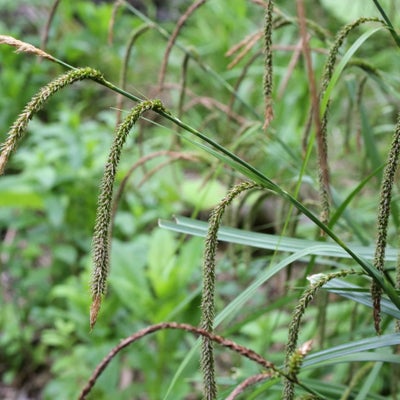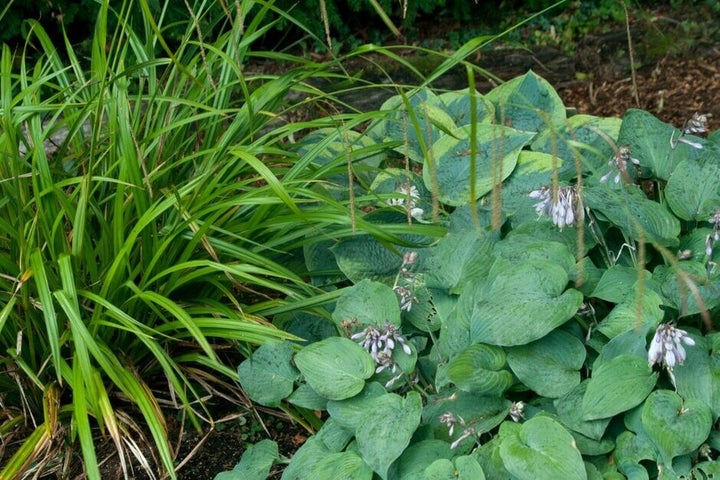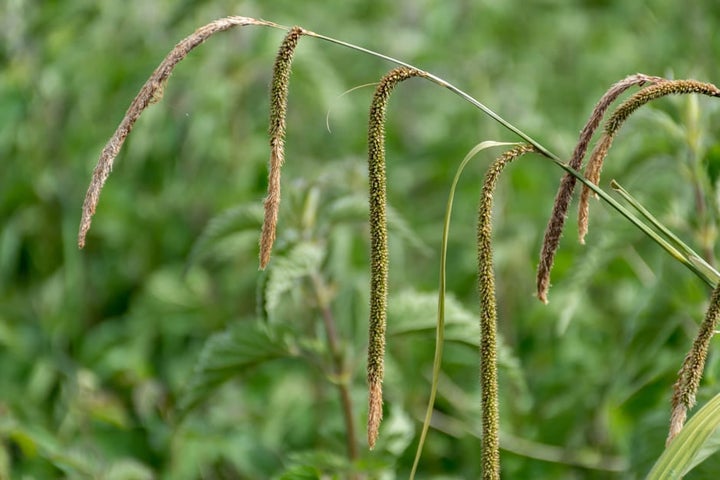
Quick facts
The botanical name for pendulous sedge is Carex pendula; it is also known as weeping sedge
It is a UK native, found in woodland, hedgerows and riverbanks on damp soils
Its dense evergreen leaves provide winter shelter for insects
If you need to control pendulous sedge, non-chemical methods are effective
What does pendulous sedge look like?
Pendulous sedge is a tufted, grass-like, evergreen that forms dense clumps up to 1m (3 1/2ft) wide.
- Long, strap-shaped leaves with sharp edges and pointed tips grow to 90cm (3ft) long. They have 3-4 pleats along their length.
- Arching flower stems appear from within the clump in May and June. They can reach 1.4m (4½ft) and bear drooping, catkin-like spikes of yellow-brown flowers.
- Flowerheads turn into seedheads in June and July, each with hundreds of small seeds that ripen from green to brown.

Did you know?
Pendulous sedge is an ancient woodland indicator – its presence in woodland, along with other indicator species, suggests that the site has been continuously wooded for a long period of time. Ancient woodlands are those that have existed, mostly unchanged, since the 17th century and developed complex ecosystems of plants, animals and fungi. For more information on ancient woodland visit The Woodland Trust.
Is pendulous sedge a weed?
Pendulous sedge is a UK , found throughout the country in woodland, hedgerows and along riverbanks. Its preference for damp soil makes it a useful for gardens on heavy, clay soils and for planting in bog gardens and around ponds.

It is a good plant for wildlife too, with its dense, evergreen foliage providing winter shelter for insects and its leaves are eaten by caterpillars of the Twin-barred Dwarf moth. Also useful for humans, its strong, strap-like leaves can be woven into rope and matting, and its edible seeds can be toasted and ground to make flour, or added to salads.
However, pendulous sedge self-seeds readily and can quickly start appearing around a garden, in borders and lawns, if not managed. It also grows to form a sizeable clump, so can smother and outcompete smaller plants.
What is a weed?
The term ‘weed’ describes a plant that is growing where it isn’t wanted. Weeds usually thrive in average garden conditions, reproducing and spreading easily. It is up to you to decide what you call a weed and what you choose to retain or remove.
Frequently asked questions about controlling pendulous sedge
Here are our answers to your most common questions about dealing with pendulous sedge:
How invasive is pendulous sedge?
Pendulous sedge self-seeds readily, with each flower spike producing hundreds of seeds. Many fall and germinate around the base of its parent – so a single plant can quickly become a clump of several. This is good news if you are growing it in a ‘tricky’ spot, such as on a steep bank, but may not be so welcome in ornamental borders or next to lawns.
Seed is also easily transported by the wind, so you may find new plants popping up around your garden. Luckily, deadheading pendulous sedge prevents self-seeding, and it is easy to remove any that do appear.

Do I need to get rid of pendulous sedge?
No – allowing pendulous sedge to grow in a woodland-edge border, bog garden, wildlife corner, damp meadow or less-cultivated area is a great way to boost the of your garden and support your garden’s wildlife.
It is, however, a good idea to promptly deadhead plants if you don’t want them to self-seed. You can manage the size of , by dividing them in spring, so they don’t smother nearby plants.
Take care
The leaves of pendulous sedge have sharp edges and the stiff flower spikes can be a hazard at eye level, so take care to site this plant away from paths and walkways and remove any seedlings that appear there.
What is the easiest way to kill pendulous sedge?
If you have pendulous sedge growing where it is not wanted, there are several ways to control it:
In borders
- flower spikes – promptly remove flower spikes in midsummer, before they develop into seeds, to prevent self-seeding. Cut these down to within the foliage to keep the clump looking neat.
- Reduce the size of established plants – use a sharp spade to cut out and lift away outer sections of the clump in mid- to late spring. This stops plants getting too large for their allotted space and smothering others growing nearby.
- Fork out seedlings – use a hand fork to remove seedlings as soon as they are seen, inserting it to its full depth to get the out in one go. Removing plants when they are young, compared to digging out established clumps, is easy and reduces soil disturbance.
- Dig out plants – do some exploratory digging around the rootball to determine its spread and depth, then use a border fork to lever the plant from the soil. You may need another pair of hands to lift out a large clump. Backfill the resulting hole with topsoil.
- Improve drainage – mulch your borders with organic matter, annually in spring, to improve drainage and make conditions less favourable for pendulous sedge.
Top Tip
Don’t add the flower spikes of pendulous sedge to your home compost bin, as it may not reach high enough temperatures to kill any seeds that have developed. Instead, put them in your council green waste recycling bin or take them to your local recycling site.
In lawns
- Mow regularly – unlike lawn grasses, pendulous sedge does not cope well with regular mowing, and plants will quickly lose vigour and die if their leaves are regularly trimmed.
- Dig out plants and reseed bare patches – use a hand fork or trowel to dig out individual plants that appear among your sward. Use topsoil or garden to fill any resulting holes before sowing grass seed. This is best done in spring or autumn when grass seed will germinate quickly and grow strongly.
- Keep lawn grass in good health – a good spring/summer and autumn maintenance regime encourages dense grass growth, making it harder for the seeds of pendulous sedge to find bare soil on which to germinate.
Top Tip
Wear gloves when handling pendulous sedge as its leaves have sharp edges.
Should I use weedkiller?
No – as pendulous sedge is easy to control by , digging and mowing, there is no need to use a weedkiller. Carex are resistant to selective lawn weedkillers, and non-selective ones kill your lawn grasses too, so non-chemical controls are your best option.
For more information, see our page on Weeds: non-chemical controls.










